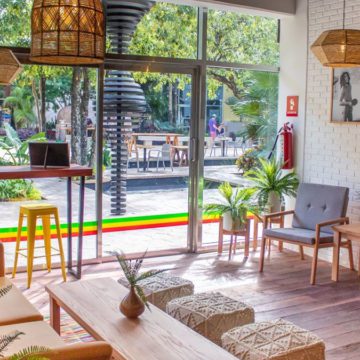By Nigel Spence
CJ Contributor
Landing in the heart of Tel Aviv was certainly not part of my normal playbook, but became a reality when I accepted an invitation to attend a wedding ceremony.
After thirteen hours of travel with my brother in tow, we landed at Ben Gurion airport. This was our first experience being in the air for anything north of 5 hours, and it was only because of the many conversations about food and culture with other passengers that kept our sanity while being locked up in this metal tube for what seemed a lifetime. Suffice to say we were quite famished by the time we made it out of the airport and hit the road but we were well equipped with the names of some recommended spots to hit in Tel Aviv. After swiftly moving through a few of the suggestions with our voracious appetites two things became clear. The first is that I could easily be a vegetarian if food prepared this fresh was available to me back in New York, and secondly, I developed an instantaneous love affair with hummus.
One would think that such basic ingredients of pureed chick peas and sesame seeds could only be so exciting, but as we continued on our food crawl through each hummusia as the small storefronts that served hummus were called, it became apparent that this humble but decadent preparation is the centerpiece of many a heated political, territorial and culinary debate.
Where it originated, the ingredients used and method of preparation were all fiercely defended by the proponent of each demographic. Without sufficient knowledge of history, I could only offer comment on one aspect of the hummus wars, which was simply to say that every single bowl I consumed since landing in Tel Aviv was ridiculously damn good and would forever change the way I felt about hummus.
It was just as amazing to realize on my return to the States how such a decadent preparation could be so unanimously screwed up without the love and respect of technique and quality ingredients that was the case in New York.
I consequently spent months searching for my long lost love that I met in Tel Aviv only to be disappointed time and again. My least favorite hummus (if there was such a thing) I ate in Israel was a far cry better than the best hummus I had in the United States.
I came to the grim realization that I was never going to experience hummus love without returning to Israel or creating that love for myself. The latter was a lot cheaper and required less time in the air, so I set out to create some love in my own kitchen.
After many experiments of soaking, boiling, simmering, sourcing of different trial and error ingredients including but not limited to Israeli, Greek, Italian, Spanish and Palestinian olive oil, sesame seeds, garbanzo beans, chick peas, tahini, yogurt, sour cream, Meyer lemons, sumac, zaatar etc.; I concluded that simply finding the freshest basic ingredients and using proper technique was far more important than where the ingredients originated.
I settled on the recipe that most closely reminded me of the elusive texture of my Israeli hummus experience, more so than flavor, of which they varied greatly.
This recipe is certainly better than you will probably get in any supermarket or restaurant in the United States, but I can’t say that it could measure up to what one would experience while travelling through the Middle East, as I would need a few hundred more years to perfect it.
I have prepared countless batches of hummus with different techniques and levels of excitement from the tasting panel. (random bar patrons on a Friday night at the restaurant).
Some methods were extremely time consuming and ingredient heavy, while others were super easy and made in a flash.
I made batches from dried, canned and frozen chick peas, and I even made my own tahini from sesame seeds.
Level of difficulty as it turns out, was not directly related to the final taste test scores, so I stuck with the recipe that was least time consuming but returned the best feedback from the hummus aficionados.
It turns out that the quality and technique applied to one particular ingredient and that is what makes good versus great hummus.
It’s all in the tahini.
Choosing the best quality 100% sesame seed tahini is the number one thing you can do to get great results.
Secondly, it should be whipped with a standing mixer with a little water, lemon juice and garlic added until smooth and airy. If that’s not an option in your kitchen, then at least a food processor or a blender can be a good substitute.
Third, most recipes usually call for equal amounts of chickpeas to tahini, or slightly more chickpeas to tahini, but I actually prefer the opposite. I tend to use 1 1/2 cups tahini to 1 cup of chick peas, and depending on the application, sometimes even more tahini.
Boiling dry chickpeas definitely yields a slightly superior texture and flavor that is harder to come by using the canned variety, but in my fast paced world the difference is just not worth the effort unless I plan to impress a friend from the Middle East, and in that case I still look for frozen instead of using dry, which gets you closer to perfection without the labor intensive process.
I am not a brand loyal kind of guy but in this instance, since this recipe is all about the tahini, I will mention that my favorite brand is Soom Sesame Organic Tahini, or Brad’s Organic Tahini, as they both have the pourable, velvety texture that I prefer to get to my desired end result. Yes, you can make your own, but why would you with such good quality brands available.
I love bold and bright flavors so I am heavy handed on the lemon juice and garlic. I also love spice, so like an old- school island man, I add scotch bonnet to everything!
Feel free to cut back on any of these ingredients if you prefer a milder version. The garlic cloves can be blanched for a minute to get a less sharp, rounded flavor before adding to the mixture.
Hummus is usually finished with a few Middle Eastern spices and some olive oil, but I sometimes heat some coconut oil instead to drizzle over it along with dried scotch bonnet pepper and freshly chopped cilantro.
Jamaican Hummus
1 1/2 Cup Tahini
1 Cup canned or previously frozen Garbanzo beans (chick peas)
1/2- 1 cup cold Water
1/4 cup fresh squeezed Lemon juice
10 cloves Garlic, finely chopped
2 teaspoons Salt (yes, it needs that much)
2 teaspoons finely chopped Scotch bonnet pepper
Finishing Oil and spices
1 tablespoon Olive oil (substitute warm coconut oil)
1/2 teaspoon Sumac (optional)
1/2 teaspoon Zaatar (optional)
1/2 Tablespoon chopped Cilantro
1/2 tablespoon dried Scotch bonnet pepper
METHOD:
Add tahini, lemon juice and salt to the bowl of mixer or food processor and blend for 1 minute. Slowly add water in a stream until mixture is smooth and silky like the texture of thick pancake batter. Mixture will get thicker before it ultimately loosens up while streaming the water in.
If using the mixer, then transfer the mixture from mixing bowl to a food processor, then add the chick peas, garlic and scotch bonnet pepper. Blend for a minute, adding additional water as necessary to keep the mixture smooth and silky and not too thick and chunky.
Transfer to a large bowl and spread hummus all the way around and up the side of the rim of the bowl, creating a well in the middle.
Sprinkle with any and all of the optional spices and olive or coconut oil. Serve at room temperature.
Nigel Spence, a Culinary Institute of America alumnus, was born in Kingston, Jamaica. Nigel freelanced at the Television Food Network for 3 years where he worked with culinary luminaries such as Mario Batali, Bobby Flay and Emeril Lagasse. Chef Spence has appeared twice on Throwdown with Bobby Flay where he emerged the victor in cook offs against the Food Network star and was featured on CBS when he appeared on Tony’s Table as well as ABC’s Neighborhood Eats, NBC’s The Today Show , Sirius’ Everyday Living with Martha Stewart and TVFN’s Chopped. The acclaimed and New York Times-reviewed Ripe Kitchen and Bar is Mr Spence’s first entrepreneurial endeavour.







